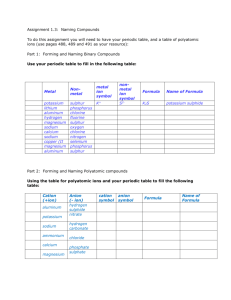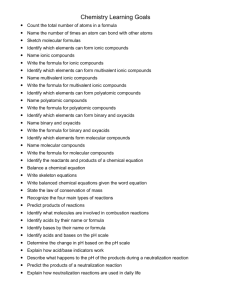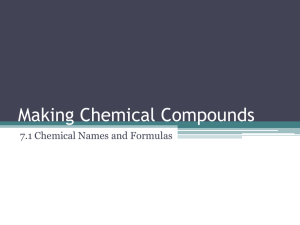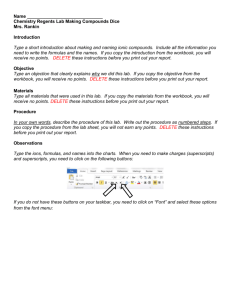BCLN_Chem_11_U3P1_Io..
advertisement
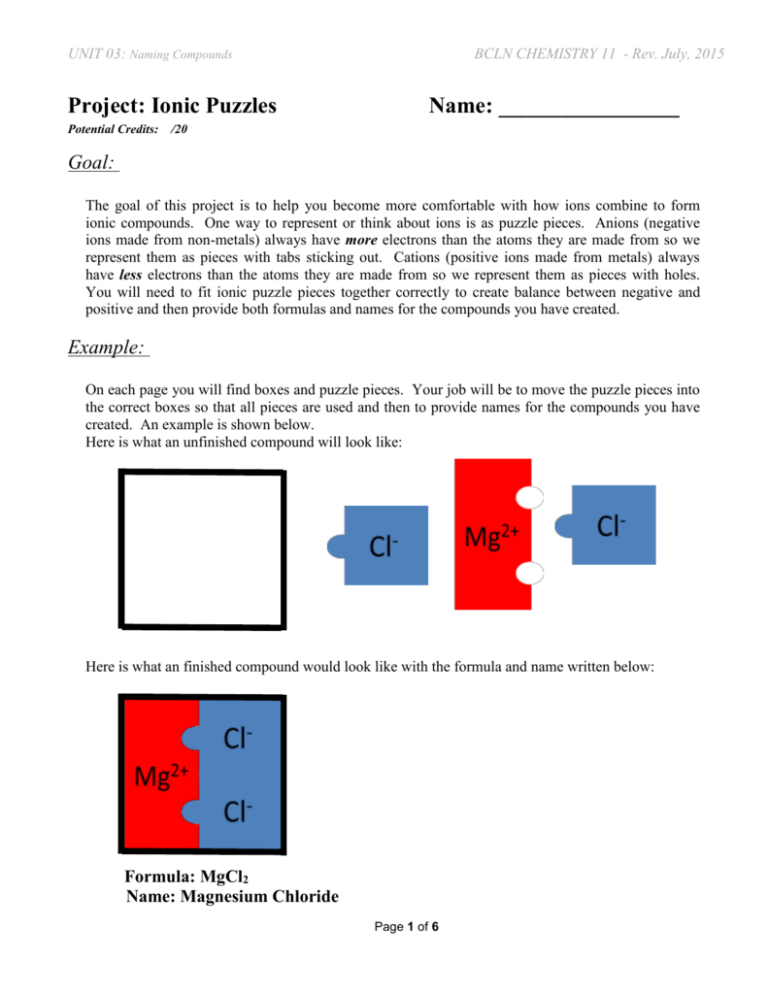
UNIT 03: Naming Compounds Project: Ionic Puzzles Potential Credits: BCLN CHEMISTRY 11 - Rev. July, 2015 Name: ________________ /20 Goal: The goal of this project is to help you become more comfortable with how ions combine to form ionic compounds. One way to represent or think about ions is as puzzle pieces. Anions (negative ions made from non-metals) always have more electrons than the atoms they are made from so we represent them as pieces with tabs sticking out. Cations (positive ions made from metals) always have less electrons than the atoms they are made from so we represent them as pieces with holes. You will need to fit ionic puzzle pieces together correctly to create balance between negative and positive and then provide both formulas and names for the compounds you have created. Example: On each page you will find boxes and puzzle pieces. Your job will be to move the puzzle pieces into the correct boxes so that all pieces are used and then to provide names for the compounds you have created. An example is shown below. Here is what an unfinished compound will look like: Here is what an finished compound would look like with the formula and name written below: Formula: MgCl2 Name: Magnesium Chloride Page 1 of 6 UNIT 03: Naming Compounds BCLN CHEMISTRY 11 - Rev. July, 2015 Monovalent Ionic Compounds: Monovalent ionic compounds are ones in which the metal only has one possible charge. Naming them is quite straightforward. You write the name of the metal first. Then you write the name of the non-metal but you change the ending to IDE. For example oxygen becomes oxide. Complete the four boxes below by moving the pieces around to create three ionic compounds. Remember there should be no left over pieces when you are done. Provide formulas and names for each. Formula: Name: Formula: Name: Formula: Name: Formula: Name: Page 2 of 6 UNIT 03: Naming Compounds BCLN CHEMISTRY 11 - Rev. July, 2015 Polyatomic Compounds: Polyatomic compounds are a special form of ionic compounds where one or both of the ions is made from a combination of non-metals rather than just a single non-metal. However the rules for combining them are essentially the same as for simple ionic compounds. Nothing will change about how you arrange the puzzle pieces. In the formulas you use brackets ONLY if you have more than one of an ion. For example Al2(SO4)3 you need brackets because you have three sulfate ions. CaSO4 you do not need brackets because you only have one sulfate ion. Complete the five boxes below to create polyatomic compounds. Provide formulas and names for each. Formula: Name: Formula: Name: Formula: Name: Formula: Name: Formula: Name: Page 3 of 6 UNIT 03: Naming Compounds BCLN CHEMISTRY 11 - Rev. July, 2015 Multivalent Ionic Compounds: Some metals are able to form ions with more than one charge. These are called multivalent metals. When naming an ionic compound you must always check your periodic table to determine if the metal is multivalent. You will know a metal is multivalent if you see more than one charge. When naming a compound with a multivalent metal you must use a roman numeral in the middle of the name. For example FeCl2 is Iron (II) Chloride. Complete the five boxes below to create multivalent ionic compounds. Provide formulas and names for each. Formula: Name: Formula: Name: Formula: Name: Formula: Name: Formula: Name: Page 4 of 6 UNIT 03: Naming Compounds BCLN CHEMISTRY 11 - Rev. July, 2015 Acids: There is a simple way to recognize almost any acid. It's formula will begin with an H. However there is a slight wrinkle. If the acid is organic (contains a C-H bond) then it's formula will end with an H instead. If the acid is created from hygroden and a non-metal you put hydro at the start of it's name. If it is created from a polyatomic ion then you make the following changes when naming the acid. ATE becomes IC. ITE becomes OUS. Complete the four boxes below to create acids. Provide names and formulas for each. Formula: Name: Formula: Name: Formula: Name: Formula: Name: Page 5 of 6 UNIT 03: Naming Compounds BCLN CHEMISTRY 11 - Rev. July, 2015 Putting it all together: Anything is possible on this page. For each compound you need to recognize what type it is (simple ionic, polyatomic, multivalent, acid) and use the appropriate naming rules. Complete the four boxes below to create compounds. Provide names and formulas for each. Formula: Name: Formula: Name: Formula: Name: Formula: Name: Page 6 of 6



